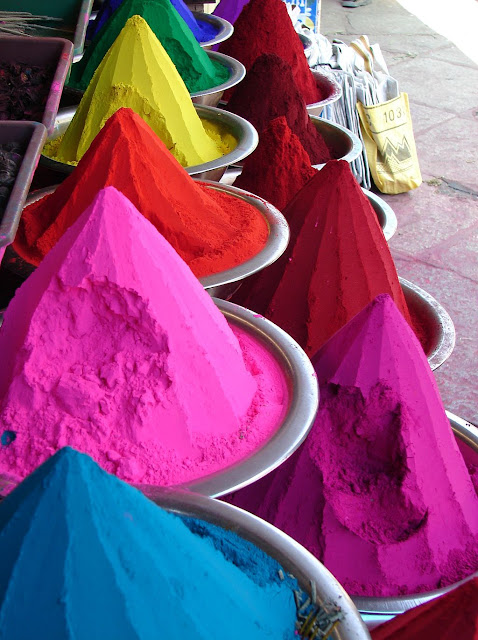Celebrating Maatu Pongal in Penang, Malaysia
Thai Pongal is a four-day Tamil
harvest festival that according the Gregorian Calendar is normally celebrated from
the 14th to the 16th of January. This corresponds to the
last day of the Tamil month Maarghazi to the third day of the Tamil month Thai.
Thai Pongal is one of the most important festivals celebrated by Tamil people
in the Indian State of Tamil Nadu and Tamils worldwide, included those in
Malaysia. The days marks the start of the sun’s six-month-long journey
northwards. Thai Pongal is mainly celebrated to convey appreciation to the Sun
God for a successful harvest. Thai refers to the tenth month of the Tamil
calendar and Pongal usually means festival or celebration….it more specifically
translates as ‘boiling over’ or ‘overflow’. Pongal is also the name of the
sweetened dish of rice boiled with lentils that is ritually consumed on this
day. Symbolically Pongal signifies the gradual heating of the earth as the Sun
travels northwards to the equinox.
Pongal dish
Besides rice and milk the
ingredients of the sweet dish include cardamom, raisins, Green gram (Mung beans) and cashew
nuts. Cooking is done in sunlight, usually in a porch or courtyard, as the dish
is dedicated to the Sun god, Surya. The cooking is done in a clay pot that is
decorated with coloured patterns called Kolam. Pongal has two variants, one
sweet and one savoury and it is served on banana leaves.
Jaggery (undistilled sugar cane or palm sugar concentrate) is added to sweeten the Pongal.
The days of the festival
Bhogi.
The day preceding Pongal is
called Bhogi. On this day people discard old belongings and celebrate new
possessions. The people assemble at dawn in Tamil Nadu to light a bonfire to
burn the discards. Houses are cleaned, painted and decorated to give a festive
look.
Thai Pongal
The main event takes place on the
second day of the four days. During the festival, milk is cooked in a vessel
and when it starts to bubble and overflows out of the vessel, freshly harvested
rice is added to the pot.
Sometimes the overflowing gets a bit boisterous.
Pongal is served to everyone in the house along with savouries and sweets. Tamils decorate their homes with banana and mango leaves and embellish the floor with decorative patterns drawn using rice flour. Kolams are drawn on the doorsteps and family elders present gifts to the young.
Pongal is served to everyone in the house along with savouries and sweets. Tamils decorate their homes with banana and mango leaves and embellish the floor with decorative patterns drawn using rice flour. Kolams are drawn on the doorsteps and family elders present gifts to the young.
Maatu Pongal
Matu Pongal is celebrated on the
day after Thai Pongal. Tamils regard cattle as sources of wealth for providing
dairy products, fertilizer and labour for plowing and transportation. On Maatu
Pongal, cattle are recognized and treated affectionately. On this day celebrants
bath and decorate their cattle with garlands. Cows are painted with turmeric water
and oil. Kumkum (shown below) is painted on their foreheads and their horns are painted.
The cows are fed a mixture of venn Pongal, jaggery, honey, banana cooked goodies and other fruit.
Traditionally torches are lit and cattle are spiritually blessed or negative spirits relating to cattle ownership exorcised.
Kaanum Pongal
Kaanum Pongal, the fourth day of
the festival, marks the end of Pongal festivities for the year. The word kaanum
in this context means ‘to visit’. Many families hold reunions on this day.
Celebrants chew sugar cane and again decorate their houses with Kolam.
Relatives and friends receive thanks for their assistance supporting the
harvest. In the community we visited in Penang....it was designated ladies day where the young maidens went to the temple to find suitors.
Penang Pongal
There are clearly regional
variations on how Pongal is celebrated. When I first arrived in Penang and
started photographing wildlife in the region I came across a fellow
photographer Sanjeevi Gopal and we shared a number of adventures together.
In
several locations, we came across cows being sent out to graze on the road
edges and in fields. These were owned by local Tamils who did not possess
grazing fields but herded their cows to graze locally on ‘common’ land. At night
they are returned to the to their shelters clustered in certain areas along the
side of roads. In this situation because the cattle were not grazing family
fields the young male cattle were sold to local Malays for Hari Raya celebrations
while the females were used for breeding. While the Tamils continued their
connection and gratitude to their cattle as local situations dictate it is different from regions in India.
In January of 2014 Jeevi took Helen and I to introduce us to several families celebrating the Maatu Pongal. We decided to take a friend to the celebrations again this year (2017).
In January of 2014 Jeevi took Helen and I to introduce us to several families celebrating the Maatu Pongal. We decided to take a friend to the celebrations again this year (2017).
The celebrations begin in the early evening when the cows return to their respective barns after a day of grazing on roadside pasture.
A number of the cows had calves that were only days old.
The standout feature of these visits was how friendly the Tamil
families were and how they embraced our curiosity and shared their food with us.
Especially delightful were the children wearing their best and padding around
the cow yards often in bare feet.
Interestingly in a mixture of tradition and non-tradition one family we celebrated with were Christian and crosses adorned their pots and barn.
While the local Tamils are possibly not as connected to their cattle as those in rural Tamil Nadu it is great see traditions being kept in expatriate communities.














































